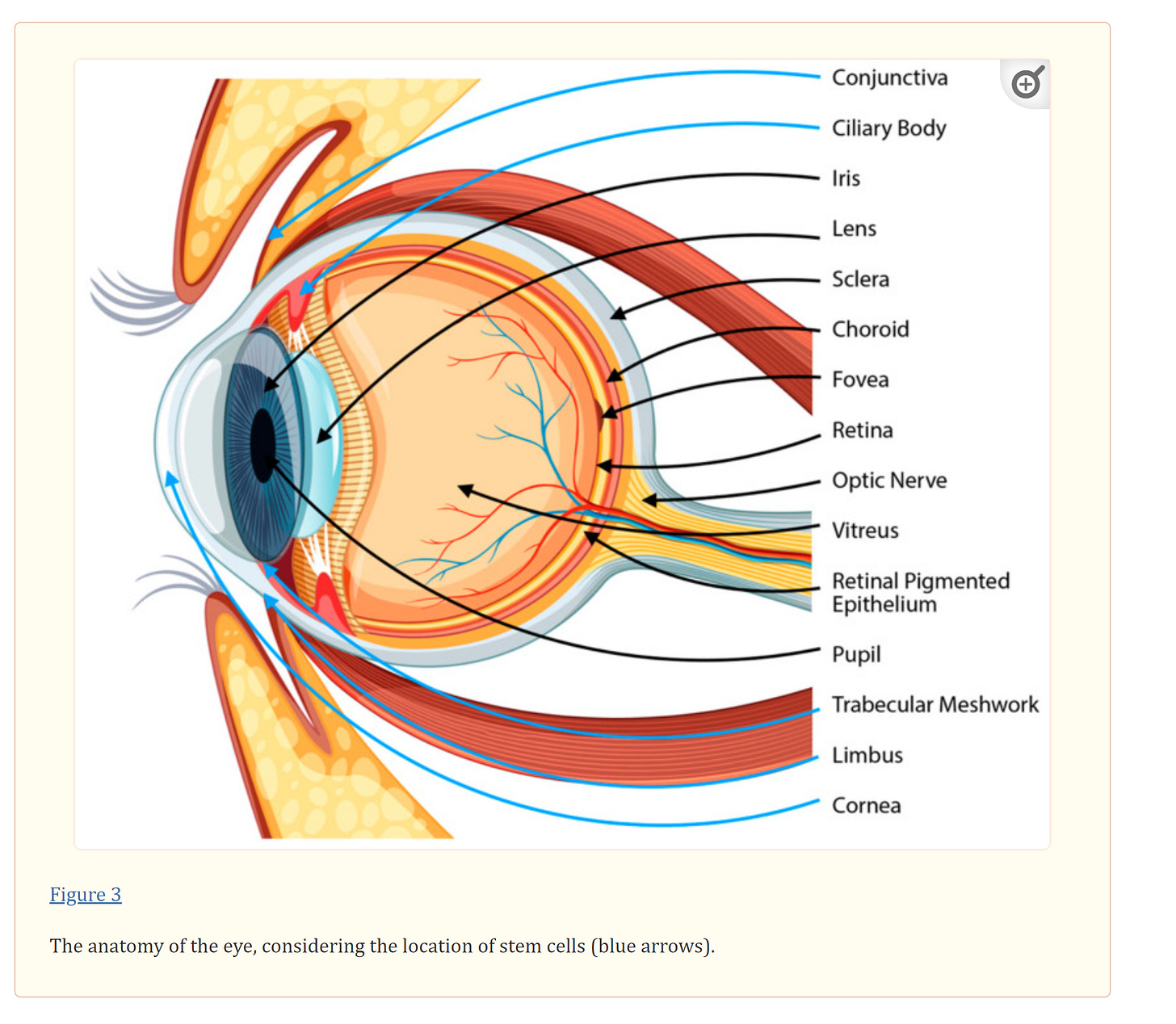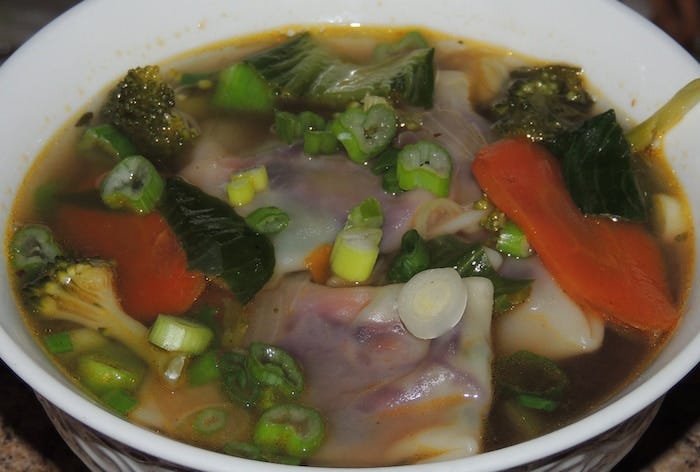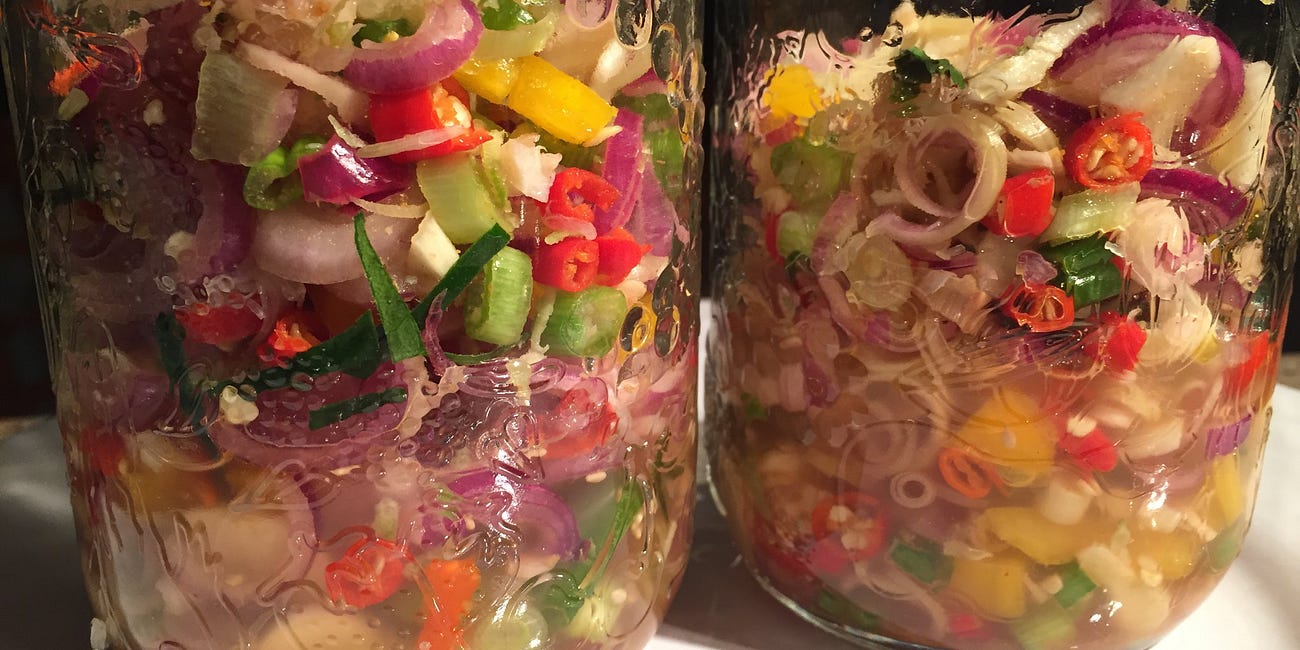Ocular-Regenerative and Ocular-Protective whole foods and naturally occurring plant/fungal compounds
This is Installment #9 of the Stacking Functions in the Garden, Food Forest and Medicine Cabinet series.
This is the second official post of a number of posts I will be sharing on here that offer intel on specific foods and/or medicinal herbs/fungi that have the potential to help you to heal (and/or optimize the function of) particular parts of the body as well as to protect your body against external sources of toxicity, inflammation or other deleterious effects on your cells. These posts represent some of the specialized dietary lists I will including in my next book (Stacking Functions in the Garden, Food Forest and Medicine Cabinet : The Regenerative Way From Seed To Apothecary).
The eyes are the window to the soul and the gateway through which we can experience the beauty of Creator’s artistry here on this physical plane of existence. While there is much to be said about combining an open heart, with courage and persistence to appreciate the beauty of Creator’s design as someone like Helen Keller chose to, most of us are in no hurry to permanently experience the world in that way.
Thus, the following information is intended to help you feel empowered to embrace health sovereignty when it comes to maintaining optimal eye health, mitigating and/or preventing degenerative ocular conditions and helping your eyes to have the best chance of healing from some injuries (such as corneal abrasions).
While modern science and industrial allopathic medicine may have developed some impressive tools for diagnosing eye conditions and surgery to remedy some problems this post is about giving your body the tools to regenerate damaged ocular cells and optimize the function of your existing ocular cells in your eyes. This is about teaming up with nature and using food as medicine so that we can enhance our ability to appreciate and navigate this beautiful world and be able to extend the amount of years that we can perceive it through the eyes (without technological or synthetic pharmaceutical assistance).
Ocular-Regenerative and Ocular-Protective Whole Foods and naturally occurring plant compounds:
Lutein, Zeaxanthin, Lycopene, Vitamin A ( Beta-carotene is a form of vitamin A), Vitamin B12, Vitamins C and E, Vitamin D, Omega-3 polyunsaturated fatty acids, Selenium, Lactoferrin, Curcumin, Flavonoids, Anthocyanins, Catechins and Zinc; these are some of the most powerful antioxidants and phytonutrients which prevent eye problems such as poor night vision, glaucoma, dry eyes, macular degeneration and cataract.
Here is a detailed list of Herbs, Vitamins, minerals and naturally occurring medicinal compounds which help the eyes heal and function optimally:
This herb can reduce the risks of glaucoma and macular degeneration by acting as a cerebro-spinal dilator.
This is an ancient cure known for enhancing circulation around the back of the eye. It helps by making sure that there is enough blood supply circulating throughout the eye.
Another common reason in ancient medicine for using ginkgo biloba is its powerful effect on vision. The antioxidants present in ginkgo helps keep the ocular system clear of oxidative stress, thereby preventing macular degeneration and cataracts.
Stem cell research has brought new hope for the treatment of neurological, ocular and cardiovascular diseases. The key to stem cell therapy lies in inducing the specific differentiation of stem cells into nerve cells. Because the differentiation of stem cells in vitro and in vivo is affected by multiple factors, the final differentiation outcome is strongly associated with the microenvironment in which the stem cells are located. Accordingly, the optimal microenvironment for inducing stem cell differentiation is a hot topic.
The extract of leaves of the Ginkgo biloba tree is used worldwide and is becoming one of the focuses of stem cell research. Studies have shown that ginkgo leaf extract can antagonize oxygen free radicals, stabilize cell membranes, promote neurogenesis and synaptogenesis, increase the level of brain-derived neurotrophic factors, and replicate the environment required during the differentiation of stem cells into nerve cells.
(Other foods which I have posted articles on (such as Echinacea, Tulip Trees, Goji Berries and others I have yet to write about such as Shiitake (Lentinula edodes), Reishi (Ganoderma lucidum), Maitake (Grifola frondosa) and Heart-leaved moonseed aka ‘Guduchi’ stem extract (Tinospora cordifolia) offer Hematopoietic Stem Cell Supportive roles).
Goji berries are exceptionally rich in zeaxanthin, an antioxidant known for its superb benefits for the eyes. They are often considered a natural treatment for age-related macular degeneration. The zeaxanthin in the berries also protects the eyes from UV exposure, free radicals, and various other forms of oxidative stress.
Even those already suffering from AMD should try some gojis – a major study has shown that consuming lutein and zeaxanthin can slow the progression of macular degeneration once it has started.
What’s more, the antioxidants in goji berry may even be a natural way to prevent glaucoma by protecting the cells in the retina.
One study published in the American Academy of Optometry’s Optometry & Vision Science journal found that drinking goji berry juice daily as a dietary supplementation for 90 days increases plasma zeaxanthin and antioxidant levels significantly, which protect eyes from hypopigmentation and accumulation of oxidative stress compounds that can damage the macula. Other studies show that the goji berry benefits eye health by protecting the retina from ganglion cells, meaning gojis’ antioxidants act as a natural treatment for glaucoma
Goji Berries are one of the richest edible plant sources known for zeaxanthin content. Up to 77% of total carotenoids present in Goji berry exist as zeaxanthin.
- Turmeric
It has powerful anti-inflammatory effects and is a very strong antioxidant. It turns out curcumin is an especially potent anti-inflammatory when fermented. In fact, it is so powerful that it closely matches the effectiveness of the most expensive anti-inflammatory drugs. Turmeric’s anti-inflammatory qualities may have benefits for patients with a variety of other eye conditions, including macular degeneration, cataracts, diabetic retinopathy, and uveitis. By inhibiting inflammation, turmeric also contributes to lower blood pressure, which is helpful since high blood pressure is known to unnecessarily stress the eye’s health.
Turmeric is famous enough for its antiseptic properties. But it also helps reduce the oxidation of the eye lens, something which is the cause of many eye problems.
Curcumin has powerful beneficial effects on eye diseases, such as glaucoma, cataract, age-related macular degeneration, diabetic retinopathy, corneal neovascularization, corneal wound healing, dry eye disease, conjunctivitis, pterygium and anterior uveitis.
- Gotu kola (Centella asiatica)
It is well known to have biological activities, including wound healing, anti-inflammatory, antidiabetic, cytotoxic, and antioxidant effects that help protect against and heal eye injuries.
Gotu Kola also clears the liver and brightens the eyes. It may help with eye disorders like night blindness in children, inflammation, cataracts, and glaucoma.
Gotu Kola is effective for inhibiting or preventing photochemical damage and photoreceptor apoptosis, which cause age-related eye degeneration.
- Ginger
Stem cells are the fundamental building blocks of the human body. Cells can differentiate and reproduce any tissue such as heart tissue, corneal cells, retinal cells, muscle, cartilage, bone, or liver. Newborn children have a lot of circulating stem cells that are needed for development and can quickly help them recover from infectious diseases and injuries. As we age, the quantities of circulating stem cells in the body begin to reduce each year, making healing and recovery much more difficult over time. You can increase the production of endogenous stem cells via eating specific superfoods (including ginger) to boost your health and circulating stem cell count.
Being rich in vitamins A and B6, elderberries can help prevent serious vision ailments like glaucoma and macular degeneration. The antioxidant activity of elderberries also helps ensure vision health in the long run.
Elderberry is also rich in anthocyanins and catechins and stimulates the visual pigment, thus improving the quality of vision.
Other berries such as blueberry and haskap berry also help to Preserve your vision and eye health due to their high levels of antioxidants such as lutein, zeaxanthins and vitamin C. Dark blue and purple berries such as these provide natural antioxidants and help improve macular pigment optical density.
- Kale
Kale is rich in vitamin C, zinc and beta-carotene - all of which improve eye health, especially while sight and eye health can decline while aging.
Kale is also high in lutein and zeaxanthin, which are two antioxidants that research has shown are effective lowering the risk of common eye disorders such as cataracts and macular degeneration.
- Nettle
It contains high levels of beta-carotene and vitamin A, which are both crucial to eye health.
These are the same nutrients that make carrots so famously good for your eyesight. While they won’t necessarily give you the ability to see in the dark, beta-carotene and vitamin A are both essential to the healthy functioning of our corneas.
The beta-carotene content of nettle leaves is 10 times that of wheat and barley flour. This vitamin is essential to maintaining a healthy retina and ensuring an adequate response to light.
It's associated with better vision and eye health, as it helps prevent cataracts. The health benefits of sauerkraut also include better blood flow in eye vessels and improved ocular function for the regeneration of new tissues. It's rich in vitamins B6, C, and K2, which are known to reduce the risk of eye disease.
Red and Orange Peppers are rich in vitamin C and beta-carotene, which help protect your eyes from damage caused by free radicals.
- Amaranth
Amaranth contains vitamin A, which is known to improve vision. The vitamin is important for vision under poor lighting conditions, and it also prevents night blindness (caused by vitamin A deficiency).
The vitamin A found in amaranth also has a major effect on the health of our ocular system. Beta-carotene is an antioxidant that prevents the development of cataracts and can slow the onset of macular degeneration.
Sweet potatoes are full of Beta-carotene, which is a carotenoid and antioxidant that promotes night vision and overall good eyesight. Sweet potatoes are also loaded with vitamins C and E. Diets that are rich in these vitamins can help prevent or delay the development of cataracts and macular degeneration
- Winter Squash (such as butternut or pumpkin)
Winter squash provides good levels of vitamins C and B6 and beta-carotene and also has lutein and zeaxanthin. These nutrients help to slow the progression of macular degeneration and reduce the chances of related vision loss.
- Edible Blue Green Algae (Spirulina and Chlorella)
Chlorella and Spirulina contain high amounts of lutein and zeaxanthin, two carotenoids that protect the eye and lower the risk of macular degeneration.
Studies have also shown that Spirulina ingestion protected retinal photoreceptors from photostress in the retina (meaning both UV and artificial “blue light”).
- Chrysanthemums (aka Mums)
Chrysanthemum has a long history of being used to treat blurred or spotty vision. It also contains beta-carotene and is a good source of vitamin Bs like choline, folacin, niacin, as well as riboflavin. In China, it is common to sip on a cup of chrysanthemum tea for dry or sore eyes after long hours of visual focus. The flowers have anti- inflammatory properties and their natural vitamin C content fights germs and infections. A little tea made from chrysanthemums will make an eye wash that can combat infections.
Benefits for Eye Health:
1. Improves Vision: Chrysanthemum is traditionally used to enhance vision and treat eye conditions like blurred vision and dry eyes.
2. Reduces Eye Strain: It helps to relieve eye fatigue, especially beneficial for people who spend long hours on screens.
3. Anti-inflammatory: The flower has anti-inflammatory properties that help reduce redness, swelling, and discomfort in the eyes.
- Dandelion Flowers and Greens
Dandelion flowers contain carotenoids, which are pigments that contribute to the vibrant yellow color of the flowers. These carotenoids, including beta-carotene, violaxanthin, and neoxanthin, act as antioxidants, protecting eye cells from damage.
Dandelion greens are also a good source lutein and zeaxanthin, which are beneficial for eye health. These carotenoids help protect the retina from light damage and reduce the risk of age-related macular degeneration and cataracts. Dandelion greens also contain beta-carotene, another carotenoid that can be converted into vitamin A in the body, which is also essential for eye health.
- Beets
Beet greens are an excellent source of lutein, a powerful antioxidant. Lutein supports eye health and helps reduce the risk of age-related macular degeneration, cataracts, and other conditions. Additionally, beets contain a host of phytochemicals that can help enhance optic health.
Echinacea also contains compounds that increase the rates of mitochondrial biogenesis and also increases the rate of endogenous stem cell production in the bone marrow.
That really has profound implications for health in general, but is especially helpful for the healing of wounds (and in particular the regeneration of internal tissues, whether it be bone tissue, ocular cells, tendons, muscle or even heart cells).
Medicinal Mushrooms for Vision:
- Reishi Mushroom: The Adaptogen for Eye Health.
Improved Circulation: Reishi supports healthy blood circulation to the eyes, which is vital for delivering oxygen and nutrients to delicate eye tissues.
Combating Oxidative Stress: Reishi's antioxidant properties help combat oxidative stress, a key contributor to age-related macular degeneration (AMD). These antioxidants help slow the progression of AMD.
Reishi mushrooms offer strong antioxidants that inhibit reactive oxygen species and their lipid oxidation. An ethanol extract augments cellular antioxidant defense through activation of the transcription factor, Nrf2/HO-1. Transcription factors are proteins that convert DNA into RNA. Reishi also inhibits neurodegeneration, promotes nerve cell differentiation, and performs other neuro-supportive effects that could slow down the progress of optic nerve related illnesses.
Reishi mushrooms may also support retinal health. One study found that Reishi mushroom spores inhibited cell death in the retina by inhibiting Bax, Bcl-xl and Caspase-3 expression. These are molecules which act as proteins and play a role in apoptosis (cell death).
- Cordyceps Mushroom: Protecting Your Eyes from the Inside Out.
Their potential has also been highlighted in recent studies. Their unique blend of bioactive compounds offers advantages for eye health as well.
Fighting Oxidative Stress: Cordyceps boasts potent antioxidants that protect eye cells from oxidative damage, a major factor in eye diseases.
Taming Inflammation: Persistent inflammation contributes to many eye problems. Cordyceps helps ease inflammation, potentially supporting treatment for various eye conditions related to inflammatory processes.
- Lion's Mane Mushroom: Promoting Optic Nerve Health.
It's gained attention for its potential benefits in brain health and for stimulating nerve growth factor (NGF) production according to studies. This unique property suggests promise for promoting eye health.
Protecting Optic Nerves: Healthy optic nerves are crucial for transmitting visual signals to the brain. Lion's mane protects optic nerves from damage and potentially even promote their regeneration, making it interesting for managing conditions like optic neuropathy.
Antioxidant and Anti-inflammatory: Like other medicinal mushrooms, lion's mane provides antioxidant and anti-inflammatory benefits. These properties help protect the delicate structures of the eyes.
Lion's mane has been found to help repair nerve damage, reduce anxiety and depression, protect against ulcers, manage diabetes, and exhibit antimicrobial action. It stimulates nerve growth in brain cells, spinal cord cells, and in the retina.
- Oyster Mushroom: Natural Support Against Cataracts.
Oyster mushrooms (Pleurotus ostreatus) are common culinary mushrooms, but research suggests they also hold potential for maintaining eye health. A study demonstrated oyster mushrooms' ability to help prevent cataracts.
Protecting the Lens: The antioxidants found in oyster mushrooms help protect the lens of the eye from oxidative damage, a major contributing factor to cataract development.
- Tomatoes
Lutein and zeaxanthin belong to the xanthophyll family of carotenoids commonly found in tomatoes
- Grapeseed
The extract of this seed is rich in phytochemicals which are good for the eyes. It also has antihistamine and antioxidant properties which are good for the all-round health of the eyes.
The antioxidants in Pawpaws, including vitamin C and carotenoids, are beneficial for eye health and contribute to healthy vision.
- Golden Seal (Hydrastis canadensis)
It is useful in reducing irritation and inflammation of the eyes. It is prepared as an eye wash for curing eye infections.
Golden Seal works to help the eyes because of Berberine. It also has properties that regulate proper heartbeat and optimize bloodflow.
- Calendula (aka Marigold)
Marigold, also known as calendula, have been used for medicinal purposes for centuries. One of the many benefits of this beautiful flower is its ability to improve eye health. Marigold is an excellent natural remedy for vision problems, particularly those related to age and exposure to blue light.
The benefits of marigold flower for eyes include its ability to prevent age-related macular degeneration, improve visual acuity, and reduce eye strain caused by prolonged exposure to digital screens.
1. Preventing Age-Related Macular Degeneration
Age-related macular degeneration (AMD) is a common eye disease that affects millions of people around the world, particularly those over the age of 50. It is a leading cause of vision loss and blindness. Fortunately, marigold flower can help prevent and treat AMD.
Marigold flowers contains high levels of lutein and zeaxanthin, two powerful antioxidants that are essential for eye health. These antioxidants help protect the retina from oxidative stress caused by free radicals and blue light exposure. Studies have shown that people who consume higher levels of lutein and zeaxanthin have a lower risk of developing AMD.
2. Improving Visual Acuity
Marigold flower can also help improve visual acuity, particularly in people with poor night vision. Lutein and zeaxanthin help filter out blue light, which can cause glare and reduce visual clarity. By improving the filtering ability of the eye, marigold flower extract can enhance visual acuity and make it easier to see in low light conditions.
3. Reducing Eye Strain from Digital Screens
With the increasing use of digital devices in our daily lives, many people are experiencing eye strain and discomfort. Prolonged exposure to blue light emitted by digital screens can cause eye fatigue, dry eyes, and headaches. Fortunately, marigold flower can help reduce these symptoms.
Lutein and zeaxanthin in marigold flower can help protect the eyes from blue light emitted by digital screens. By filtering out harmful blue light, marigold flower can reduce eye strain and discomfort. In addition, marigold flower can also help increase tear production, which can reduce dry eye symptoms caused by digital screen use.
- Eyebright (Euphrasia)
This herb helps soothe itchy eyes and conjunctivitis. It has been used for a long time in Europe.
- Passionflower
It is known to relax the blood vessels in the eyes.
- Fennel (Foeniculum vulgare)
Fennel is said to be particularly helpful for watery and inflamed eyes. Apart from these mild conditions, Fennel can also be used to treat cataracts and glaucoma.
Fennel has nutrients like Vitamins A and C which are antioxidants that help in preventing macular degeneration. Also, the nutrients in Fennel can help in slowing down cataract from worsening.
- Carrots
Carrots are a well-known source of vitamin A.
- (non-gmo free range) Eggs
They not only contain Vitamin A but also lutein, zeaxanthin, and zinc which are vital for healthy eyes. Vitamin A protects the cornea. Lutein and zeaxanthin reduce the possibility of having serious eye conditions like macular degeneration and cataract. Zinc improves the visibility at night and helps Vitamin A form a pigment, called, Melanin, which protects the cornea. Having one or two eggs a day is sufficient to keep the eyes healthy.
- Sea buckthorn berries (Hippophae rhamnoides)
Proanthocyanidins (PACs) from sea buckthorn seeds protect retinas from harmful effects.
The antioxidants present in the berries also may help protect the eyes from oxidative stress and inflammation.
Sea Buckthorn berries are rich in carotenoids - giving the golden color - including the vitamin A precursor beta-carotene and eye protecting lycopene.
- Hazelnuts:
Hazelnuts are good for eye health due to their high vitamin E content. Vitamin E is an antioxidant that helps protect the eyes from harmful molecules and slows the progression of age-related macular degeneration (AMD) and cataracts.
Vitamin E:
Hazelnuts are a good source of vitamin E, an antioxidant that helps neutralize free radicals in the body. Free radicals can damage eye cells and contribute to the development of eye diseases like AMD and cataracts.
Other Nutrients:
For more info on Hazelnuts and how to grow them, read:
Besides vitamin E, hazelnuts also contain other nutrients that are beneficial for eye health, such as zinc and omega-3 fatty acids. These nutrients contribute to overall eye health and protect against vision problems.
- Green Tea
Catechins, the active constituents of green tea, are reputed for their antioxidative, anti-inflammatory, and anti-angiogenic activities. Studies found that catechins exerted antioxidative activities in these tissues and suggesting that these compounds could be used as potential medicine for oxidative ocular diseases associated with oxidative stress.72 In addition, many other studies showed that catechins can protect nerves in retina following ischemia/reperfusion insult.73
Catechins and green tea extract can also suppress sodium iodate-induced oxidative retinal degeneration.
- Kelp, Seaweed and other sea vegetables (such as Dulse/”Irish Moss”) boast an impressive nutritional profile, packed with an array of essential vitamins, minerals, and other bioactive compounds. Among the key nutrients found in these marine wonders are:
Iodine: Seaweed is one of the richest natural sources of iodine, a vital mineral essential for thyroid function and hormone production. Adequate iodine intake is crucial for maintaining metabolic rate, energy levels, and overall health.
Vitamins: Sea vegetables are rich in vitamins A, C, E, and K, all of which play crucial roles in supporting various aspects of eye health. Vitamin A, for instance, is essential for the synthesis of rhodopsin, a pigment in the retina that aids in low-light vision.
Minerals: Seaweed and sea vegetables are abundant sources of minerals such as calcium, magnesium, potassium, iron, and zinc, which are essential for maintaining bone health, ocular cell regeneration, muscle function, and immune system function.
Antioxidants: These marine plants contain a myriad of antioxidants, including carotenoids, flavonoids, and polyphenols, which help combat oxidative stress, inflammation, and cellular damage caused by free radicals. By protecting ocular tissues from oxidative damage, antioxidants contribute to maintaining healthy vision and reducing the risk of age-related eye diseases.
Eye Health Benefits of Seaweed/Kelp
Incorporating seaweed and sea vegetables into your diet can offer a multitude of benefits for eye health and vision wellness. Some of the key advantages include:
Supporting Visual Clarity: The vitamins, minerals, and antioxidants found in seaweed and sea vegetables help support various aspects of visual function, including visual acuity, contrast sensitivity, and color perception.
Protecting Against Age-Related Macular Degeneration (AMD): The antioxidant compounds present in these marine plants help protect the macula, the central part of the retina responsible for detailed central vision, from oxidative damage and degeneration associated with AMD.
Preventing Cataracts: Antioxidants like vitamin C and carotenoids found in seaweed and sea vegetables help reduce the risk of cataract formation by neutralizing free radicals and protecting the lens of the eye from oxidative stress.
- Bilberry (Vaccinium myrtillus)
The benefits of these berries were discovered by British pilots in World War II. They said that they helped their night vision. Bilberries help blood circulation in the smallest of capillaries. They also contain anthocyanosides which help the eye adjust to various levels of light.
This plant is great for improving night vision. A supplement from this plant can help you see more clearly if you have a hard time driving at night.
- Jaborandi (Pilocarpus jaborandi)
This herb is good for those who suffer from glaucoma. It is highly effective in the early stages of glaucoma. To use, just drip an oil of Jaborandi on the eye affected by glaucoma and it should provide comfort.
- Bilwa (Aegle marmelos)
It is used to heal painful eye diseases like sty and conjunctivitis. This herb is rich in protein, pectin and some amounts of minerals like iron, phosphorus, calcium and magnesium.
It is commonly prepared as a nutritious cold drink. The extract of this fruit is mixed with water, sugar and tamarind and this makes it a healthy delicious beverage good for eyesight.
- Triphala
Triphala is a potent Ayurvedic formulation comprising of three incredible ingredients, namely Amla (Emblica Officinalis), Haritaki (Terminalia chebula) and Bibhitaki (Terminalia bellirica) -all of which are well-known powerful ingredients in Ayurvedic medicine. Due to this, Triphala offers a wide range of nutrients and bioactive plant compounds, such as vitamins, sodium carbs, gallic acid, minerals, chebulinic acid, chebugali acid and many others that benefits the human body in many different ways. It has been known to help in regulating blood sugar levels, promoting digestion and also in detoxifying the liver and kidneys. But among all these, its benefits for eyesight and overall eye health are the most well-known and are even backed by modern-day science and research studies. Triphala preparations are widely available in the market in the form of powder, tea, juices, syrups, capsules or extract.
Generally, Triphala is usually ingested orally for health purposes. However, topical application in the form of eye drop or eyewash is another popular way to help address eye problems. Triphala eyewash is known to be extremely beneficial in treating eye inflammation, redness, dry eyes and strain that resulted from long hours of exposure to digital screens aka computer vision syndrome. Additionally, the rich vitamin C and antioxidants content of Triphala also proves to be helpful in protecting the eyes from damage related to oxidative stress.
Benefits of Triphala for Eye Health:
No matter how it is used or consumed, Triphala is undeniably a powerful health booster and an excellent natural remedy for eye health. Here is a list of how Triphala benefits eye health:
1. Prevents Eye Infection
Triphala formulation is home to potent nutrients that are especially helpful for the eyes. It is rich in vitamin A, which is known to be beneficial for treating and preventing irritations and infections associated with the eyes. It is also helpful in reducing inflammation, red and dry eyes and eye strain.
2. Combats Oxidative Stress
Triphala possesses excellent antioxidant properties due to its rich vitamin C content. This is beneficial for fighting free radicals from damaging healthy cells in the body. Preparation like Triphala eyewash is known to be helpful in reducing eye damage caused by oxidative stress.
3. Strengthens Eye Muscles
In Ayurveda, Amla is touted as a powerful ingredient that enhances vision and overall eye health. It is also known to help improve and strengthen eye muscles, which in turn helps in supporting good, healthy eyesight and overall eye health.
4. Reduces the risk of Age-related Eye Problems
Haritaki, which is another key ingredient in Triphala, is an excellent plant with rich anti-ageing properties. This makes Triphala formulation a great natural remedy for eye health, especially in treating age-related eye problems.
5. Treats Macular degeneration & Cataract
With a rich mix of potent ingredients, Triphala is packed with powerful bioactive plant compounds that are helpful in preventing and improving this eye condition, such as macular degeneration, as well as senile cataracts that are associated with age, cigarette smoke and constant exposure to UV radiation.
- Cape gorses (Asphalatus)
This herb has been used for thousands of years by South African Bushmen because it helps improve the immune system and also helps in maintaining healthy eyesight. It is rich in nutrients like calcium, iron, zinc, antioxidants and magnesium.
Ocular-Regenerative and/or Ocular-Protective vitamins, nutrients, minerals and phytochemicals:
- Lutein and zeaxanthin
Lutein and zeaxanthin are antioxidants found in the pigments of leafy green vegetables and other brightly colored foods. They are key to protecting the macula, the area of the eye that gives us our central, most detailed vision. Goji berries (as well as goji berry leaves) Kale and spinach have plenty of these nutrients. Other foods with useful amounts of lutein and zeaxanthin include curry leaves, spearmint, green chilli, coriander leaves, mustard seeds, romaine lettuce, collards, turnip greens, broccoli and peas. And while not leafy and green, eggs also are a good source of these nutrients.
- Lycopene.
- Vitamin A ( Beta-carotene is a form of vitamin A)
The richest sources of beta-carotene are yellow, orange, and green leafy fruits and vegetables (such as carrots, orange tomatoes, orange peppers, goji berries, spinach, lettuce, tomatoes, sweet potatoes, broccoli, cantaloupe, and winter squash). In general, the more intense the color of the fruit or vegetable, the more beta-carotene it has.
- Vitamin B12
- Vitamins C and E
Vitamin C is critical to eye health. As an antioxidant, vitamin C helps protect the body from damage caused by some things we eat, unhealthy habits and environmental factors. Fried foods, tobacco smoke and the sun’s rays can produce free radicals--molecules that can damage and kill cells. Vitamin C helps repair and grow new tissue cells.
Good sources of vitamin C include citrus fruits, such as oranges, tangerines, grapefruit and lemons. Lots of other foods offer vitamin C, including peaches, red bell peppers, tomatoes and strawberries. Antioxidants can prevent or at least delay age-related macular degeneration (AMD) and cataracts, according to the Age-Related Eye Diseases Study (AREDS).
Another important antioxidant is vitamin E, which helps keep cells healthy. Vitamin E can be found in avocados, almonds and sunflower seeds.
- Vitamin D
- Zinc
The mineral zinc helps keep the retina healthy and protects your eyes from the damaging effects of too much direct UV light. However, zinc can lower the amount of copper in your body, which we need to help form red blood cells. Fortunately, you can increase both at once with all kinds of beans (legumes), including black-eyed peas, kidney beans and lima beans (especially when fermented). Other foods high in zinc include oysters, lean red meat, poultry and fermented veggies.
- Omega-3 polyunsaturated fatty acids
- Selenium and Lactoferrin
- Curcumin
- Flavonoids
- Anthocyanins
- Catechins
- Glutathione
Glutathione, a potent antioxidant, is naturally present in the eye's aqueous humor, lens, and cornea, composed of three amino acids: glutamine, cysteine, and glycine. Certain vitamins and minerals are crucial for glutathione production and maintenance, including cysteine, glutamate, glycine, Se, vitamin C, vitamin E, and Zn, obtained from various dietary sources.
𝗙𝗼𝗼𝗱𝘀 𝘁𝗵𝗮𝘁 𝗰𝗼𝗻𝘁𝗮𝗶𝗻 𝗚𝗹𝘆𝗰𝗶𝗻𝗲:
– Spirulina
– Seaweed
– Watercress
– Amaranth (greens and seeds)
– Organic Bone Broth
– Spinach
– Legumes (runner beans, soybeans, peanuts and peanut butter, peas, mung beans, lentils, and kidney beans etc, preferably fermented as miso paste if it is soy beans).
– Organic Gelatin (such as you would use to make jello or gummies)
– Asparagus
– Nuts and seeds (such as pumpkin or squash seeds, hemp seeds, butternuts, walnuts, sunflower seeds, almonds, flax seeds, sesame seeds and chai seeds)
– Cabbage
– Bamboo shoots
– Kale
– Yogurt/ Kefir (from grass fed animals or you`ll get loaded up with glyphosate from their gmo grain feed)
N-acetyl cysteine (NAC) is a supplement form of cysteine.
𝗖𝘆𝘀𝘁𝗲𝗶𝗻𝗲 𝗶𝘀 𝗳𝗼𝘂𝗻𝗱 𝗶𝗻 𝗮 𝗿𝗮𝗻𝗴𝗲 𝗼𝗳 𝗵𝗶𝗴𝗵-𝗽𝗿𝗼𝘁𝗲𝗶𝗻 𝗳𝗼𝗼𝗱𝘀 𝗮𝗻𝗱 𝘀𝗼𝗺𝗲 𝘃𝗲𝗴𝗲𝘁𝗮𝗯𝗹𝗲𝘀/𝗵𝗲𝗿𝗯𝘀, 𝘀𝗼𝗺𝗲 𝗲𝘅𝗮𝗺𝗽𝗹𝗲𝘀 𝗶𝗻𝗰𝗹𝘂𝗱𝗲:
– shiitake mushrooms
– spirulina
– yogurt or cheese (from grass fed animals or you`ll get loaded up with glyphosate from their gmo grain feed)
– eggs (from organically raised chickens)
– sunflower seeds
– organic sourdough bread
– Dates
– Ginseng
– legumes (same story as above, fermented is better, especially with soy beans and obviously watch out for the ones dosed with glyphosate)
– Peppers
– Cabbage
– Garlic
– Onions
– Kale
– Nuts (pecans, cashews, hazelnuts, almonds, and Brazil nuts)
– Seeds (sesame seeds, amaranath seeds, hemp seeds etc)
𝗙𝗼𝗼𝗱𝘀 𝘁𝗵𝗮𝘁 𝗰𝗼𝗻𝘁𝗮𝗶𝗻 𝗚𝗹𝘂𝘁𝗮𝗺𝗶𝗻𝗲:
– Spirulina
– Seaweed (such as dulse, nori or kombu)
– Yogurt and Ricotta Cheese (from grass fed animals or you`ll get loaded up with glyphosate from their gmo grain feed)
– Legumes (same story as above)
– Red cabbage
– organic Eggs
– Nuts
– Parsley
– Dark Leafy Greens (such as amaranth greens, mustard greens, spinach, collard greens, kale, lettuce, radish greens, and cilantro, are good sources of glutamine)
– Organic Bone Broth
– Nuts and seeds (such as cashews, hazelnuts, pistachios, coconut milk, pumpkin or squash seeds, hemp seeds, butternuts, walnuts, sunflower seeds, almonds, flax seeds, brazil nuts, sesame seeds and chai seeds).
An additional list of foods that contain Lutein and zeaxanthin:
https://www.myfooddata.com/articles/high-lutein-and-zeaxanthin-foods.php
The cornea is the outermost component of the eye’s optical system with the greatest focusing power. It comprises five layers, each of which plays a crucial role in maintaining its transparency. The outermost epithelium comprises five to seven layers of cells, with its turnover time estimated at around four days. This epithelium is embedded in the basal membrane called Bowman’s. The stroma constitutes up to 90% of the thickness of the cornea and is mainly composed of numerous layers of parallel collagen fibres that cross each other at right angles. Its posterior surface is covered with a Descemet membrane on which a single-layer flat corneal endothelium rests. Endothelium cells are responsible for the hydration of the stroma and do not proliferate, which makes them very susceptible to damage. In such a situation, the remaining cells compensate for the defects by enlarging and stretching to maintain the layer’s continuity. In addition, the cornea absorbs nutrients from the aqueous humor and oxygen via the tear film. A sixth, situated between the Descemet membrane’s matrix and membrane, was presented in 2013 .
According to the estimates, corneal opacities, currently the fourth most common cause of visual impairment, result in moderate to severe distant vision loss or blindness in 4.2 million individuals globally.
The anterior segment of the eye is particularly susceptible to oxidative stress due to constant exposure of the eye to radiation, atmosphere oxygen, industrial chemicals, and physical abrasions. The retina is considered one of the highest energy-demanding and oxygen-consuming tissues of the body, exceeding even that of the brain. The susceptibility of the choroid to oxidative stress can be attributed to several factors including the choroid's high vascularity, located beneath the retina, which exposes it to constant oxygen and reactive oxygen species (ROS) via a rich network of blood vessels supplying the outer retinal layers, and the choroid's role in light regulation and the intricate interplay with the retinal pigment epithelium can lead to ROS generation when exposed to light, contributing to oxidative stress.
Oxidative stress is a significant contributor to various eye diseases. Some of these conditions include AMD, cataracts, DR, DED, Fuchs' endothelial corneal dystrophy, glaucoma, keratoconus (KC), ROP, RP, and uveitis.
The eyes possess intrinsic antioxidant systems to shield against oxidative stress and damage from reactive oxygen species. Melanin acts as a natural UV filter and antioxidant, helping to protect the eye from UV radiation, artificial EMF radiation and oxidative stress. Essential vitamins like A, C, E, and beta-carotene, in combination with a network of enzyme systems found in various cellular compartments, including mitochondria (housing superoxide dismutase (SOD) and glutathione peroxidase) which can be supported with (the foods listed above), peroxisomes (home to catalase), and the cytosol (containing SOD, glutathione peroxidase, ferritin, and ceruloplasmin), work in concert with crucial minerals such as Se, Cu, and Zn, to uphold the eye's defense mechanisms against oxidative stress and maintain overall health. A balanced diet rich in antioxidants is vital for supporting these natural defense mechanisms.
The risk of macular degeneration can be reduced through the consumption of antioxidant-rich foods. This article focuses on the antioxidants, vitamins, and minerals that have been shown to reduce the risk of macular degeneration and other eye-related diseases. Antioxidants including anthocyanins, carotenoids, flavonoids, and vitamins have been shown to reduce the risk of eye-related diseases. Anthocyanins extracted from berries are powerful antioxidants. Cyanidin, delphinidin, malvidin, pelargonidin, peonidin, and petunidin are anthocyanin aglycones detected in berries, currants, and other colored fruits and vegetables. β-Carotene, as well as xanthophyll lutein and zeaxanthin, have been reported to reduce the risk of macular degeneration. Flavonoids from plants help in the prevention of eye-related diseases through anti-inflammatory mechanisms. A combination of these antioxidants, vitamins, and minerals possess a synergistic effect on the prevention or risk reduction of macular degeneration.
As you can see, a wide array of metabolic processes, cofactors, vitamins, and minerals are integral to maintaining ocular structures such as the iris, retina, choroid, photoreceptors, lens, cornea, and vitreous humor. One of the lesser discussed factors in herbal medicine is the role of endogenously produced epithelial (adult) stem cells in processes such as the regeneration of the cornea (both as a natural/constant process of cellular renewal and as a means to heal from injury). As I have discussed in past posts, there are specific foods you can eat with help increase the production of epithelial stem cells within your body that can differentiate into specialized cells to heal specific organs in your body (such as your eyes, and even your heart).
The tear film is primarily water-based, containing electrolytes, proteins, lipids, and mucins. The cornea is abundant in collagen fibers, the sclera mainly comprises collagen type I, and the vitreous humor consists mostly of water, hyaluronic acid, and collagen fibrils. Additionally, collagen fibers play a key role in providing structural support to blood vessels, including those in the retina and choroids.
Collagen synthesis relies on the support and regulation of various nutrients. Amino acids, such as lysine and proline, are crucial in forming collagen fibers. Lysine, in particular, is essential for collagen cross-linking, which contributes to the cornea's structural integrity. Vitamin A, for instance, plays a role in reducing the expression of matrix metalloproteinases and stimulating collagen production. Vitamin C is crucial for collagen synthesis as it's involved in the hydroxylation of proline and lysine, which also requires oxygen and ferrous iron. Additionally, magnesium (Mg) and zinc (Zn) are necessary for the translation process associated with collagen formation, while Cu activates lysyl oxidase, facilitating cross-linking in the maturation of collagen molecules. However, it's important to exercise caution in supplement intake, as excessive levels of selenium (Se) and vitamin E, despite their essential antioxidant functions, may potentially hinder collagen synthesis. Maintaining a balanced approach to nutrition (via Whole Food sources) is key to supporting healthy collagen production.
Arginine is involved in the production of nitric oxide (NO), a molecule that regulates blood flow to the eye. Proper blood flow is crucial for nourishing the ocular tissues and maintaining healthy intraocular pressure. Coenzyme Q10 (CoQ10) is a fat-soluble compound belonging to the quinones category. It serves as an antioxidant and plays a vital role in cellular energy production. Although the primary source of CoQ10 is endogenous synthesis, it can also be obtained from dietary sources or supplements. COQ10 controls ROS levels. CoQ10 are molecules that have neuroprotective, antioxidant, and anti-inflammatory properties, and their use could have a benecial effect in ocular pathologies including DR, RP, Leber’s hereditary optic neuropathy (LHON), and AMD. CoQ10 has been proposed as a potential neuroprotective agent in glaucoma. Foods like seaweed, fermented foods, organic whole grains, nuts and seeds, and select vegetables contain CoQ10. While dietary sources contribute to overall intake, the primary source remains endogenous synthesis within the body.
The aqueous humor is mainly water, containing electrolytes, vitamin C (high concentration of ascorbic acid), and growth factors. The lens primarily consists of lens fibers and crystallin proteins that ensure transparency, benefiting from antioxidants like glutathione and vitamin C. The retina houses various neuron layers and maintaining its structure and function needs carotenoids like lutein, zeaxanthin, and omega-3 fatty acids from leafy greens and cannabis seeds.
Taurine, a sulfur-containing amino acid structurally akin to the neurotransmitters glycine and GABA, plays a crucial role in the body, being the most abundant free amino acid in the retina and the second most prevalent in the central brain after glutamate. Taurine functions as an 3 of 66 osmoregulator, essential for maintaining the balance of water and ions in retinal cells, and crucial for proper visual signal processing. Moreover, it possesses antioxidant and neuroprotective properties, shielding cells, especially neurons, from oxidative stress and potentially influencing brain function. Ongoing research continues to unveil the exact mechanisms and functions of taurine in various physiological processes. It can be found in various dietary sources, with seafood like seaweed, shellfish and fish, dairy products like cheese and milk, certain nuts as well as legumes being notable rich sources.
Beneath the photoreceptors is the retinal pigment epithelium. The RPE comprises pigmented cells with melanin which supports photoreceptors, while the choroid contains blood vessels and connective tissue. Melanin is vital, found in several eye structures, providing defense against oxidative stress, neutralizing free radicals, reducing lipid peroxidation, and absorbing different types of light. Essential vitamins and minerals support melanin production. Tyrosine is a substrate, and Cu is a co-factor for tyrosinase. Vitamin C aids in conversion and safeguards melanocytes. Vitamin B6 is involved, and vitamin E offers antioxidative protection. Vitamin A indirectly promotes melanin production, Zn plays a role in biosynthesis, Se defends against oxidative damage, and iron upregulates melanogenesis genes. Se-containing carbohydrates can inhibit melanin synthesis. B vitamins support energy metabolism and ocular structures. Many vitamins contribute to optic nerve health, including B1, B2, B3, B6, B12, folate, C, E, D, A, and K, aiding nerve function, energy production, and protection from oxidative damage.
The significance of neurons in ocular conditions and the potential of neuroprotective nutrients:
The role of neurons is crucial in various eye diseases, including dry eye, DR, glaucoma, RP, and optic neuropathies. Neurons, particularly specialized photoreceptors, can be damaged in these conditions. In dry eye syndrome, corneal nerves are vital for tear production and ocular surface health, while DR affects both blood vessels and retinal neurons. RP and degenerative retinal diseases involve the progressive degeneration of photoreceptor cells, and optic neuropathies, whether caused by glaucoma or other factors, damage retinal ganglion cells and their axons. Across these eye diseases, preserving neural tissues emerges as a primary focus in treatment and management, recognizing the significant impact of neuronal involvement in their pathogenesis. Neurotrophic factors are vital for the survival and function of neurons in the eye. Ongoing research explores the use of various neurotrophic factors and related compounds in ophthalmology. These factors and compounds hold promise in supporting the health and function of neurons in the eye. Some of these factors and their potential applications include Nerve Growth Factor (NGF) in dry eye syndrome, Brain-Derived Neurotrophic Factor (BDNF) in glaucoma and optic neuropathy, Ciliary Neurotrophic Factor (CNTF) may protect photoreceptor cells in RP and macular degeneration, and Glial Cell Line-Derived Neurotrophic Factor (GDNF) may have neuroprotective effects on retinal ganglion cells in glaucoma and optic neuropathy.
Specific nutrients and supplements indirectly increase neurotrophic factor levels, maintaining overall good health and proper nutrition is essential for supporting neurotrophic factor activity and overall neuronal health. Key nutrients and supplements that indirectly support neural health include omega-3 fatty acids, antioxidants, B vitamins, vitamin D, curcumin, resveratrol, lutein, zeaxanthin, CoQ10, ALA, and NAC.
The production of neurotransmitters plays a significant role in eye health, and these essential compounds can be obtained from specific nutritional sources. Neurotransmitters are chemical messengers that transmit signals in the nervous system, including the visual pathways. Key neurotransmitters related to eye health include dopamine, acetylcholine, and glutamate.
Neuroplasticity, the brain's remarkable capacity to forge new neural connections throughout one's life, plays a critical role in shaping and maintaining the visual system. Dopaminergic foods, influencing dopamine levels, contribute significantly to this process. During childhood, neuroplasticity fine-tunes visual processing, and specific dietary choices rich in tyrosine (such as fermented legumes, seaweed, fish, eggs, dairy products, and certain nuts and seeds) and certain fruits and vegetables (like bananas and leafy greens) have the potential to promote enhanced visual development and combat conditions like amblyopia. Dopamine, a pivotal neurotransmitter, wields its influence over various aspects of visual function, including contrast sensitivity and color perception. In cases of visual impairment, the harnessing of neuroplasticity is feasible through visual rehabilitation programs that consider dietary support. Other neurotransmitters including indoleamines, a group of organic compounds that encompass melatonin, play a pivotal role in regulating circadian rhythms and the sleep-wake cycle, indirectly contributing to eye health by facilitating proper rest and minimizing the risk of eye strain and fatigue. This is vital for sustaining optimal eye function and overall visual well-being. Although melatonin is chiefly produced by the body, certain foods from fungi to animals and plants, with eggs, fish, and nuts emerge as some of the richer melatonin sources. Other sources include cherries, grapes, strawberries, tomatoes, walnuts, and almonds contain worth while amounts of melatonin, though their dietary impact is relatively modest. Consumption of melatonin-rich foods has been associated with a significant increase in melatonin levels in human serum. Furthermore, melatonin exhibits promise in addressing specific eye conditions like glaucoma, accompanied by documented benefits for the immune system, inhibition of angiogenesis, cancer cell apoptosis induction, potent antioxidant effects, cardiovascular protection, antidiabetic and anti-obesity properties, neuroprotection, and anti-aging attributes.
The intricate link between nutrition and ocular well-being is garnering significant attention within the field of ophthalmology. This post explores the pivotal role of nutrients, phytochemicals, antioxidants, and neuroprotective elements in preserving vision, managing and potentially healing spectrum of eye conditions. The complex relationship between dietary interventions and eye health deserves to be triple underscored. Various eye conditions, from common ones like dry eye disease, cataracts, glaucoma, diabetic retinopathy, and age-related macular degeneration to rarer genetic disorders, all intersect with nutrition. Nutritional and herbal strategies offer the potential to serving as preventive measures, slowing disease progression, reducing comorbidities and enhancing the quality of life.
Both the specific understandings of ocular anatomy and biochemistry, as well as systemic, nutritional and energetic considerations are necessary to diagnose treat chronic eye diseases with herbs (which are unique to individuals and thus the most effective approaches would have to formulated by working with someone that knows your specific health situation). Formula development emphasizes the use of very specific herbs that remove inflammation and blood congestion from the eye. This is because from the traditional (and now modern) point of view certain herbs (as well as foods) have an affinity for ocular tissue.
Knowledge of the correlation between vitamin A intake and vision has been known for a long time, and we now know that specific carotenoids are equally beneficial to the eye. Lutein, zeaxanthin and lycopene should be included in everyone’s diet for prevention. To get lutein and zeaxanthin, eat lots of spinach, collard greens, kale and mustard greens (as well as Goji berries and other foods). The red carotenoid lycopene is found in watermelon, guava and pink grapefruit, though tomatoes are by far the best source. Lycopene is made more bio-available by cooking in oil, so using tomato sauce with some olive oil is probably best.
I hope you found this information to be empowering and may it bring you increased confidence, health sovereignty as well as a more vivid and long lasting window into perceiving the beauty of this world through your eyes.
For an extensive list of plant species used to traditionally treat specific eye diseases and injuries read:
References and additional data:
The Role of Nutrition and Nutritional Supplements in Ocular Surface Diseases
Dry eye disease (DED) is a multifactorial disease of the ocular surface system whose chore mechanisms are tear film instability, inflammation, tear hyperosmolarity and epithelial damage. In recent years, novel therapies specifically targeting inflammation used foods and herbs to help the healing in significant ways.
Herbal molecules in eye diseases - ScienceDirect
The number of apoptotic rods and cones inversely correlated significantly with zeaxanthin and lutein concentration in the retina in a light-damaged quail eye, demonstrating that retinal zeaxanthin protects photoreceptors from light-induced damage. Zeaxanthin supplementation inhibited lipid peroxide, protecting DNA, electron transport complex III, nitrotyrosine, and mitochondrial integrity.
Treatment of corneal epithelial cells with herbal compounds results in upregulation of the antimicrobial peptide, human beta-defensin 3 (DEFB103) | IOVS | ARVO Journals
Purpose : A previous study using immortalized colonic adenocarcinoma cells (CaCo-2) demonstrated upregulation of the endogenous antimicrobial peptide (AMP) human beta-defensin 3 (hBD3, gene: DEFB103) mRNA expression when the cells were treated with one of three Chinese herbal extracts (andrographolide, oridonin, isoliquiritigenin). The current study determined the ability of corneal epithelial cells to heal with the assistance of these herbs.
Aqueous extract of Centella asiatica promotes corneal epithelium wound healing in vitro - PubMed
Ethnopharmacological relevance: Centella asiatica is a traditional herbal medicine that has been shown to have pharmacological effect on skin wound healing, and could be potential therapeutic agent for corneal epithelial wound healing. Aim of the study: This study was done to evaluate the effects of Centella asiatica on the proliferation and migration of rabbit corneal epithelial (RCE) cells.
References and Citations:
https://cmjournal.biomedcentral.com/articles/10.1186/s13020-019-0257-6
https://www.researchgate.net/publication/376582120_Nutrients_for_Eye_Health_and_Disease_Management
https://www.sciencedirect.com/science/article/pii/S2211505614000283#cebib0010
Here are some recipes from my first book (and some that will be included in my next book) which offer a high amount of Ocular-Regenerative and Ocular-Protective foods to hopefully get you inspires to stack the functions of enjoying culinary creativity, delicious flavors and meals shared with loved ones (while simultaneously helping optimizing eye health and/or helping to heal your eyes).
Vegetable Borscht
Hello everyone! Sorry for the long gap between posts but my wife and I have been busy packaging and shipping out pre-ordered copies of my book (which recently arrived fresh off the presses).
The 5 Grain Bibim-Buddha Bowl
This "Buddha Bowl" type dish has a main theme of Korean flavors but this meal is also a passport and an invitation to embark upon a pilgrimage with your senses to visit several different cultures. It includes region specific ingredients that…
Wor-Wonton Soup with Sprouted Hokkaido Black Soy Bean Dumplings
Around this time of year I like to use up the stores of dried beans from the garden to make 'stick to your bones' type meals and this recipe is one of my favorite ways to do that. We always loved Wor Wonton soup when we went out to Chinese restaurants in the past but finding a substitute after we decided not to eat meat anymore was virtually impossible.
30 Reasons To Make Your Own Sauerkraut and Include a Daily Forkful In Your Diet (and a basic recipe from my book to make your own at home).
Preserved cabbage looks simple (and the process to make raw cabbage i…
Jeweled Tabbouleh with Ancient Grains and North African Spices
This salad is a refreshing way to enjoy many nourishing and innate immune system optimizing whole foods into a vibrant and delicious meal.
Adaptogenic Super Taco Mix
I love Mexican food (well I love a lot of food with cultural roots south of the US border going all the way down to traditional Incan territory really) so I have been experimenting with combining my passion for making tacos, burritos, enchiladas, fajitas and heuvos rancheros with my more recently acquired knowledge of
Amaranth Seed, Trail Of Tears and Hokkaido Black Soy Bean Miso Paste
"Reclaiming our food and our participation in cultivation is a means of cultural revival, taking action to break out of the confining and infantilizing dependency of the role of consumer (user) and taking back our dignity and power to become producers and creators. Though affluent people have more food choices than the people of the past could ever drea…
Sopa de Lima (Yucatán-Style Lime Tortilla Soup)
This sopa de lima, or lime soup, is a Mayan dish originally from Yucatán, Mexico.
(especially this version of my Mom’s Lime Soup that I described and shared some pics of in this note recently:
Thai Roasted Sweet Potato, Carrot and Ginger Soup
One of our favorite ways to enjoy several of our best producing crops (ginger, carrots, cilantro, sweet potato and chili peppers) is Thai Sweet Potato Soup. Typically, around mid winter we use the last of our stored carrots, sweet potatoes, ginger (and many other ingredients) to make a huge batch of this super nutritious, warming, delicious and inviting…
If you would like to have access to well over a hundred other fun and nutritious recipes like those shared above there is info to where you can purchase either a physical or digital copy of my book below.

For those interested in purchasing a physical copy of the book you can do so through this link:
https://recipesforreciprocity.com/shop/softcover/
For more on the other subjects I will be covering in my next book read:
























Another phenomenal "health monument" that rises above the money-centered allopathic regime. Thank you Gavin, if there's a book detailing these installments, I would like to purchase it. You do more to improve people's health than the UN and WHO combined (but alas it not's fair to compare you with gangsters organizations)!
This article is extensive and thorough, thank you. I'm glad to know I'm familiar with so many of these listed here